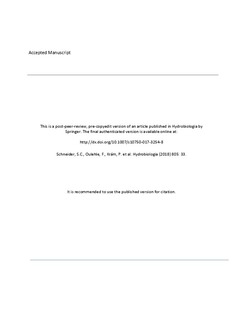| dc.contributor.author | Schneider, Susanne Claudia | |
| dc.contributor.author | Oulehle, Filip | |
| dc.contributor.author | Krám, Pavel | |
| dc.contributor.author | Hruška, Jakub | |
| dc.date.accessioned | 2019-05-29T08:00:05Z | |
| dc.date.available | 2019-05-29T08:00:05Z | |
| dc.date.created | 2017-11-29T20:58:56Z | |
| dc.date.issued | 2018 | |
| dc.identifier.citation | Hydrobiologia. 2018, 805 (1), 33-47. | nb_NO |
| dc.identifier.issn | 0018-8158 | |
| dc.identifier.uri | http://hdl.handle.net/11250/2599362 | |
| dc.description.abstract | Acidification has adversely affected freshwater ecosystems in many areas, and recovery from acidification is often interrupted by acidic events. We lack detailed information about how benthic algae react to short-term acidic events and long-term recovery from acidification. We sampled 15 stream sites in the Czech Republic to study the effects of (a) water pH, aluminium and lead concentrations, (b) short-term acidic events, (c) 20 years of recovery from acidification and (d) high phosphorus concentrations combined with low pH on soft-bodied benthic algae. Water pH and aluminium concentrations affected benthic algal assemblages, but the acidification index periphyton (AIP) mainly reflected pH. Benthic algal assemblages reflected recent acidic events more closely than maximum or average pH. Our results indicate that the reaction of benthic algae to pH results from a fast effect of pH minima that cause sensitive species to disappear within a few months, and a slower process of dispersal and competition for resources during periods of higher pH. After an acidic event, recolonization of stream sites by sensitive species had started within 2 years, and was largely completed after 9 years. Our data indicate that acidification may mask the effect of enhanced phosphorus concentrations on benthic algal eutrophication indices. | nb_NO |
| dc.language.iso | eng | nb_NO |
| dc.publisher | Springer | nb_NO |
| dc.title | Recovery of benthic algal assemblages from acidification: how long does it take, and is there a link to eutrophication? | nb_NO |
| dc.type | Journal article | nb_NO |
| dc.type | Peer reviewed | nb_NO |
| dc.description.version | acceptedVersion | nb_NO |
| dc.rights.holder | Springer International Publishing Switzerland 2017 | nb_NO |
| dc.source.pagenumber | 33-47 | nb_NO |
| dc.source.volume | 805 | nb_NO |
| dc.source.journal | Hydrobiologia | nb_NO |
| dc.source.issue | 1 | nb_NO |
| dc.identifier.doi | 10.1007/s10750-017-3254-8 | |
| dc.identifier.cristin | 1520537 | |
| dc.relation.project | Det europeiske økonomiske samarbeidsområde (EØS): EHP-CZ02-OV-1-048-01-2014 | nb_NO |
| dc.relation.project | Andre: Czech Science Foundation grant: GA15-08124S | nb_NO |
| cristin.unitcode | 7464,30,19,0 | |
| cristin.unitname | Ferskvannsøkologi | |
| cristin.ispublished | true | |
| cristin.fulltext | postprint | |
| cristin.qualitycode | 1 | |
